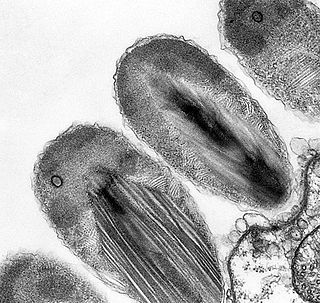
Spirochaeta is a genus of bacteria classified within the phylum Spirochaetota.
The Aquificota phylum is a diverse collection of bacteria that live in harsh environmental settings. The name Aquificota was given to this phylum based on an early genus identified within this group, Aquifex, which is able to produce water by oxidizing hydrogen. They have been found in springs, pools, and oceans. They are autotrophs, and are the primary carbon fixers in their environments. These bacteria are Gram-negative, non-spore-forming rods. They are true bacteria as opposed to the other inhabitants of extreme environments, the Archaea.

Verrucomicrobiota is a phylum of Gram-negative bacteria that contains only a few described species. The species identified have been isolated from fresh water, marine and soil environments and human faeces. A number of as-yet uncultivated species have been identified in association with eukaryotic hosts including extrusive explosive ectosymbionts of protists and endosymbionts of nematodes from genus Xiphinema, residing in their gametes. The verrucomicrobial bacterium Akkermansia muciniphila is a human intestinal symbiotic bacterium that is considered as a promising probiotic.
The Thermotogota are a phylum of the domain Bacteria. The phylum contains a single class, Thermotogae. The phylum Thermotogota is composed of Gram-negative staining, anaerobic, and mostly thermophilic and hyperthermophilic bacteria. It is the sole phylum in the kingdom Thermotogati.
Fibrobacterota is a small bacterial phylum which includes many of the major rumen bacteria, allowing for the degradation of plant-based cellulose in ruminant animals. Members of this phylum were categorized in other phyla. The genus Fibrobacter was removed from the genus Bacteroides in 1988.

The Chlamydiaceae are a family of gram-negative bacteria that belongs to the phylum Chlamydiota, order Chlamydiales. Chlamydiaceae species express the family-specific lipopolysaccharide epitope αKdo-(2→8)-αKdo-(2→4)-αKdo. Chlamydiaceae ribosomal RNA genes all have at least 90% DNA sequence identity. Chlamydiaceae species have varying inclusion morphology, varying extrachromosomal plasmid content, and varying sulfadiazine resistance.

Campylobacterota are a phylum of Gram-negative bacteria. Until the 2021 revision of bacterial taxonomy by the ICSP, the entire phylum was classified within the Proteobacteria as the Epsilonproteobacteria and the Desulfurellales. The separation of this phylum from "Proteobacteria" was originally proposed in 2017, using GTDB-based methods.

The Spirochaetaceae are a family of spirochete bacteria. Some species within this family are known to causes syphilis, Lyme disease, relapsing fever, and other illnesses.
The Synergistota is a phylum of anaerobic bacteria that show Gram-negative staining and have rod/vibrioid cell shape. Although Synergistota have a diderm cell envelope, the genes for various proteins involved in lipopolysaccharides biosynthesis have not yet been detected in Synergistota, indicating that they may have an atypical outer cell envelope. The Synergistota inhabit a majority of anaerobic environments including animal gastrointestinal tracts, soil, oil wells, and wastewater treatment plants and they are also present in sites of human diseases such as cysts, abscesses, and areas of periodontal disease. Due to their presence at illness related sites, the Synergistota are suggested to be opportunistic pathogens but they can also be found in healthy individuals in the microbiome of the umbilicus and in normal vaginal flora. Species within this phylum have also been implicated in periodontal disease, gastrointestinal infections and soft tissue infections. Other species from this phylum have been identified as significant contributors in the degradation of sludge for production of biogas in anaerobic digesters and are potential candidates for use in renewable energy production through their production of hydrogen gas. All of the known Synergistota species and genera are presently part of a single class (Synergistia), order (Synergistiales), and family (Synergistaceae).
Actinospica is a genus in the phylum Actinomycetota (Bacteria).
Adlercreutzia is a genus in the phylum Actinomycetota (Bacteria).
Deferribacter is a genus in the phylum Deferribacterota (Bacteria).
Dehalogenimonas is a genus in the phylum Chloroflexota (Bacteria). Members of the genus Dehalogenimonas can be referred to as dehalogenimonads.
Armatimonadota is a phylum of gram-negative bacteria.
Moorella is a genus of bacteria belonging to the phylum Bacillota.
Sulfurovum is a genus within the Campylobacterota which was first described in 2004 with the isolation and description of the type species Sulfurovum lithotrophicum from Okinawa trough hydrothermal sediments. Named for their ability to oxidize sulfur and their egg-like shape, cells are gram-negative, coccoid to short rods. Mesophilic chemolithoautotrophic growth occurs by oxidation of sulfur compounds coupled to the reduction of nitrate or molecular oxygen.
The Nautiliaceae are a family of bacteria placed in an order to itself, Nautiliales. The members of the family are all thermophilic.
Chloroflexales is an order of bacteria in the class Chloroflexia. The clade is also known as filamentous anoxygenic phototrophic bacteria (FAP), as the order contains phototrophs that do not produce oxygen. These bacteria are facultative aerobic. They generally use chemotrophy when oxygen is present and switch to light-derived energy when otherwise. Most species are heterotrophs, but a few are capable of photoautotrophy.
Hydrogenobacter is a genus of bacteria, one of the few in the phylum Aquificota. Type species is H. thermophilus. This genus belongs to Bacteria as opposed to the other inhabitants of extreme environments, the Archaea.
Phycisphaeraceae is a family of bacteria.



